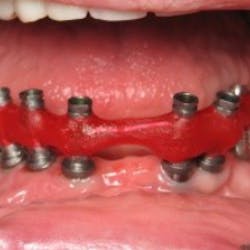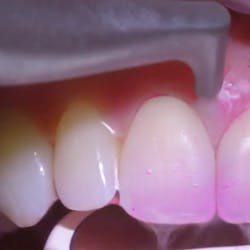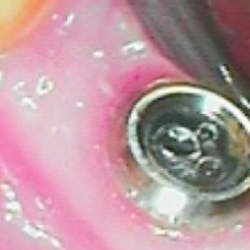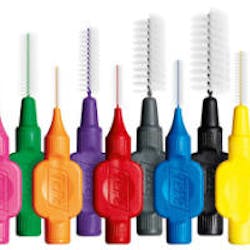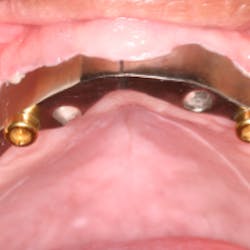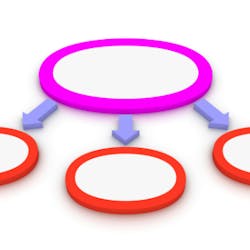By Jesse J. Hofer, DMDTemporary Anchorage Devices (TAD) are defined as implants that are removed after being used for anchorage. This alternative offers a practitioner many advantages when attempting to move teeth. This article will discuss these advantages of TADs, different systems, and treatment planning strategies for their use.In traditional orthodontics, practitioners need to consider Newton’s third law of motion: for every action, there is an equal and opposite reaction. Therefore, when bonding to teeth, the practitioner must consider undesired movement of anchor-teeth. Headgear allows the practitioner to move teeth either individually or en masse in more directions; however, compliance is frequently an issue especially with children. TADs, therefore, allow an effective alternative that is esthetic and can lead to more rapid treatment process.1Prior to bonding and moving teeth, a practitioner will extract one or more premolars to create some initial space. Size and shape of roots along with the restorative history of the teeth often dictate which teeth are extracted when treatment planning. TADs offer additional anchorage for moving teeth with roots that would make movement unfavorable. Because of this, TADs can eliminate the need for extractions that would otherwise be necessary. In certain cases, when teeth are to be moved together to close a gap that exists after extracting a tooth, anterior lip support is optimal or even deficient. TADs allow the necessary anchorage to ensure that the anterior teeth do not move distally when closing the gap. Via intrusion TADs can be used to lower the anterior facial height and eliminate lip incompetency. When a patient is partially edentulous in the maxilla, it is possible to accomplish rapid palatal expansion and arch constriction by placing TADs in the place of missing teeth. TADs allow for molar uprighting without unwanted extrusion or movement of other teeth, and close spaces eliminate the need for implants or bridges in certain cases. It is possible to correct canted occlusal planes and move arches en masse, sometimes avoiding the need for orthognathic surgery. TADs reduce the time necessary for orthodontic treatment, which can reduce the chance of deleterious effects of orthodontic appliances on teeth. These are a few rationale points for using TADs.TADS are typically one piece made with grade 5 titanium alloy. All models come with right-handed threads, but a left-handed thread can be special-ordered for those instances where torque might unscrew the right-handed thread. They can be self-screwing (no osteotomy necessary) or self-tapping (no tap necessary). Models vary by their head design. Heads can have a hook, a ball, an eyelet, a single slot, or a double slot. The hook and ball designs are useful primarily for mesial or distal translation and cannot be used for space closure or intrusion of teeth. The hook must be oriented properly, where the ball is symmetric and just needs to be tightened. The ball will least likely unscrew as a result of force. The eyelet design allows space closure and intrusion of teeth; however, careful treatment planning must be done to chose an eyelet that allows the gauge of wire to pass through while having enough strength to resist fracture (If the hole is large and the screw head is small, there will be little remaining metal holding it together). The screws with slots offer the advantages of the previous types, with the cross-slot pattern being the best. This design allows for less correction of orientation for wires (only needs to be corrected <45 degrees to align with force vectors of wires) and has the most alternative-use possibilities.When planning to move teeth, a practitioner can use a TAD for direct or indirect anchorage. With direct anchorage, a TAD is placed and teeth to be moved are compressed from or placed under tension toward the anchor. An indirect anchor simply connects a TAD to teeth that anchor other teeth and is used when you do not want the anchor teeth to move. Direct anchors typically do not provide as many force vector options, and when they fail it is noticeable. Indirect anchorage failures, including unwanted movement of anchor teeth, can be difficult to notice. Indirect anchors are more difficult to place but have failsafe mechanics compared to direct anchorage.2In conclusion, there are many advantages of TADs when moving teeth. These implants are constantly being improved upon. The implant is treatment planned with models, radiographs, and photographs. Implant position is chosen based on anatomy and desired force vectors and esthetics. TADs can improve treatment times and, in many situations, offer greater patient satisfaction.Author bioJesse J. Hofer, DMD, graduated from University of Utah with a bachelor's in bioengineering, and then graduated from the University of Pittsburgh Dental School. Dr. Hofer is currently enrolled in the postdoctoral periodontics program at the University of Stony Brook School of Dental Medicine.References1. McGuire MK. Temporary anchorage devices for tooth movement: a review and case reports. J Periodontol. Oct. 2006; 77:1613-1624.2. Ludwig B. Mini-implants in Orthodontics Innovative Anchorage Concepts. Quintessence Publishing. 2008.
Latest in Interdisciplinary Teams
Latest in Interdisciplinary Teams

